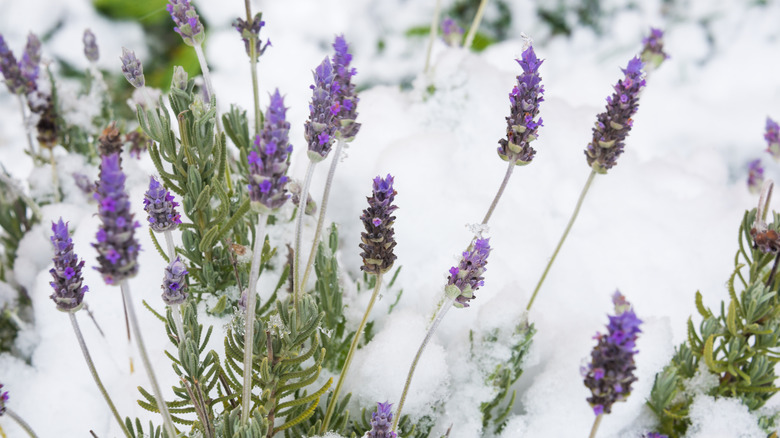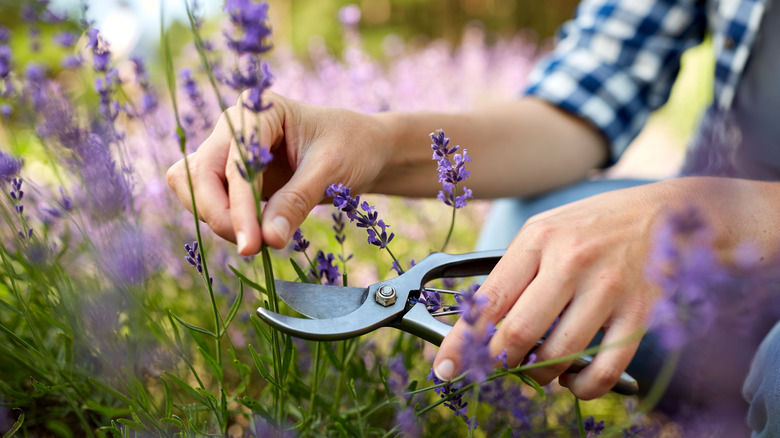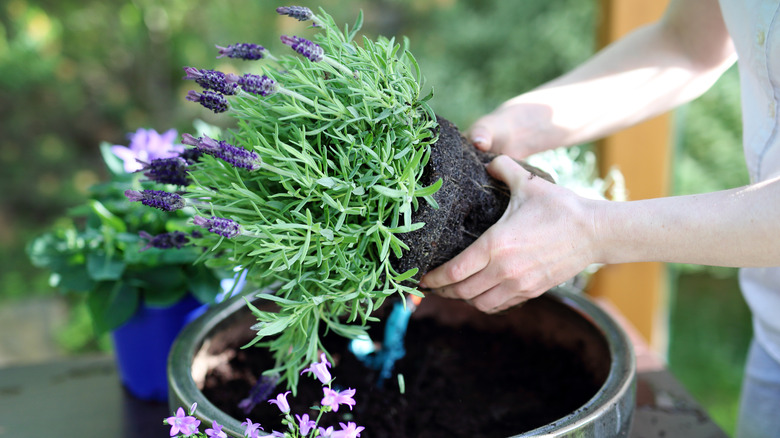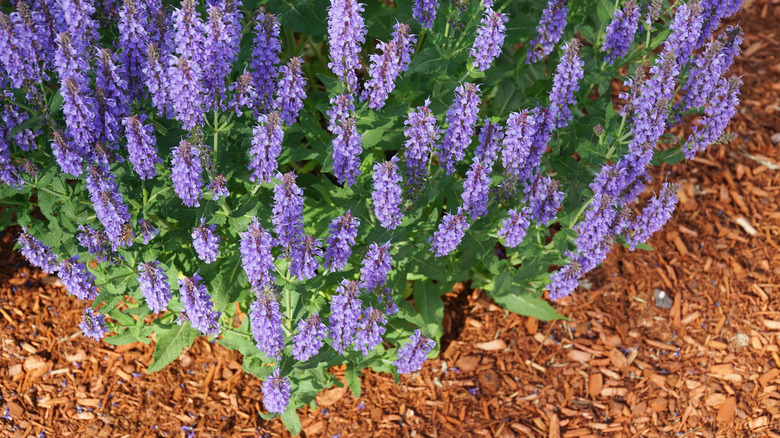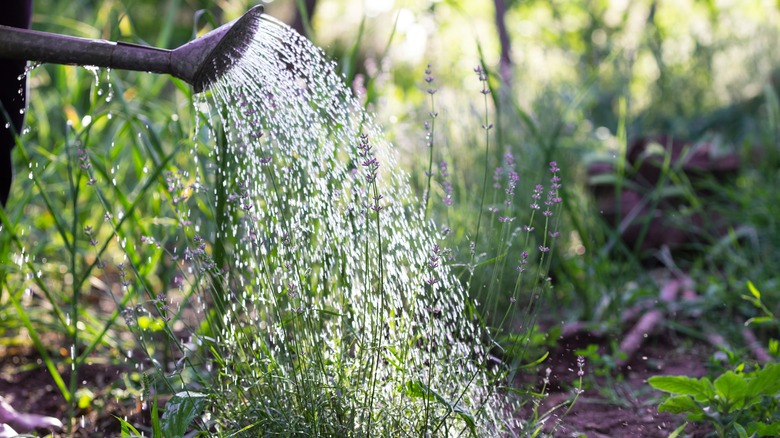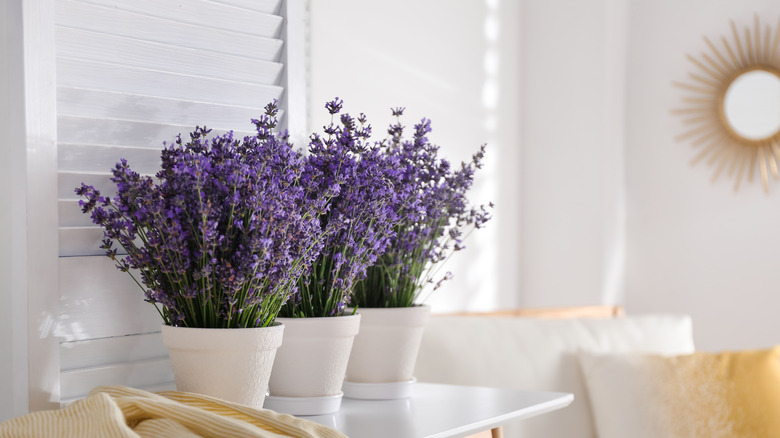How To Winterize Lavender To Protect Against Harsh Winter Weather
Lavender (Lavandula spp.) is the perfect plant to spruce up your garden with some color in the frosty season. However, without the proper care, lavender can die during harsh weather. If you have yet to think about planting it around your home, several benefits come from having a few shrubs. According to Flower Works, lavender has a potent fragrance that can relieve stress and calm the body, which is why most folks use it in essential oils around the house. In addition, you can use it when you cook or bake pastries since it mixes well with lighter flavors, such as lemon, mint, and honey. So, by taking care of your lavender throughout the winter, you'll be able to use it in multiple ways throughout the cold days.
While the plant can survive most winters in the USDA zones 5 to 10, depending on the variety you grow, it's prone to winter burn if grown in zones below 5, per Muskoka Lavender. Before winterizing your plant, ensuring a robust root system will better protect the cultivar, and if you're new to planting lavender, we've created a guide to help make the process smoother. On the other hand, if you've already planted your lavender, here are a few tips on winterizing it so it lasts until spring.
Prune the plant
When your lavender goes through its first blooming cycle, it needs to be pruned to be prepared for new flowering in the spring and summer. The Herb Exchange claims that without pruning before winter, the lavender is apt to cold and frost, causing it to rot and die. Prune it at the end of August, early September, or after the flowering cycle.
For the pruning process, you only need shears, but cutting back the stems can be tricky if this is your first time. You'll want to trim ⅓ of the branches with your shears; it's okay to eyeball the length if you don't want to measure it out, per The Herb Exchange. If you prune around 2 to 3 inches up the stem, your lavender will likely bloom in the spring; however, if you cut more than that, it won't flower. A great way to make sure the cuts are consistent is to use the first cutting to measure the rest of them. Pruning wooden branches won't promote new growth if they're brittle and old, so be sure to trim them when needed.
Check the drainage
The best way to prepare your lavender for the winter is by checking its soil and drainage. Your plants should originally be grown on raised beds instead of directly into the ground to allow good drainage to continue through the winter. Without good drainage, the soil will be too heavy and could rot the roots with excess water and insufficient oxygen, per ONspecialtycrops. When lavender doesn't get proper oxygen to its roots, it won't be able to grow and freely move through the dirt. In addition, the cultivar enjoys sandy soil since it allows more air to flow, enabling better drainage.
If you plant lavender in the ground, you can transplant it to pots before the winter months to get proper drainage from the rain. Moving it into pots is simple. First, you'll need to prepare the container you'll use for the plant. Grow Veggy suggests using a pot that's 18 inches deep and 16 inches wide for varieties other than English lavender. Fill half of the container with sandy soil and soak the dirt well before placing the rootball inside. Once the water has drained completely, use a pitchfork to remove the lavender. Seafoam Lavender suggests angling the pitchfork at a 45-degree angle as you move around the plant. Next, lift the cultivar gently from the ground ensuring the roots are intact and place it in the pot. Water once more to get the rest of the soil wet and drained.
Cover the lavender with mulch
Sage Creations claims lavender plants are dormant during the cold season, so they need a little help surviving the winter. The roots will be insulated without waterlogging by surrounding the soil with mulch. So, whether you first planted your lavender in pots or recently transplanted them, an excellent way to prevent them from freezing is to cover the top of their soil with well-draining mulch.
According to High Country Gardens, lavender grown in areas with high precipitation doesn't need to be packed with mulch since it will hold moisture that could rot the roots. However, in dry but harsh weather, the plant needs this aid in the form of crushed gravel or textured mulches, like leaves, pine needles, pea gravel, or crushed nutshells. You'll want to cover up to 2 inches of the soil with your selected mulch. Gravel or organic matter is light and allows air circulation to enter, reaching the roots. In addition, mulch reflects light, keeping the soil dry and maintaining the roots healthy.
Allow rain to replace regular watering
Since some areas receive heaps of rain during winter, it's best to stop watering the lavender and let the rainfall take care of it for you for a few months. Gardener Report suggests not watering the cultivar if you plan to leave it outdoors. However, if you live in an area with constant rain, you might want to move your plant closer to the porch or place a small bed cover over it so the rain doesn't drown it. Appropriately amending the soil insulates the roots so they won't need extra water. Because lavender is dormant in the winter, the moisture and rainfall will be enough to keep it alive.
With a superb draining system and a bed of mulch, the plant won't be harmed, and you won't have to worry about taking care of it. Unless you don't receive constant rainfall, you might have to water the raised beds every couple of weeks. Check the soil with your fingertips to determine if it needs a drink. Dry soil will require water, but damp soil can hold off, per Gardener Report. Always check with your fingers so that you don't overwater the lavender.
Keep potted plants indoors
Potted lavender is easier to take care of during the winter as opposed to it being outside because you have control over how much water it gets, the temperature it's in, and making sure it receives enough sunlight. Terrebleu suggests preparing your plant to live indoors before moving it. So, instead of placing it inside right away, move it to the porch for a few hours a day, where it'll receive less sunlight to get used to not having enough the entire day. Leave it there for a couple of weeks, then move it indoors for a few hours a day, increasing the time. After the weeks are up, you can bring the lavender inside and place it by a window so that it still gets sunlight. Then, water it when the soil is dry.
If you don't have enough time to get your lavender accustomed to the indoors, place it by a window with sufficient airflow and no humidity. Avoid places like the bathroom or the kitchen since they get warmer during the day. As long as they have sunlight and water, they won't be a big fuss throughout winter.
